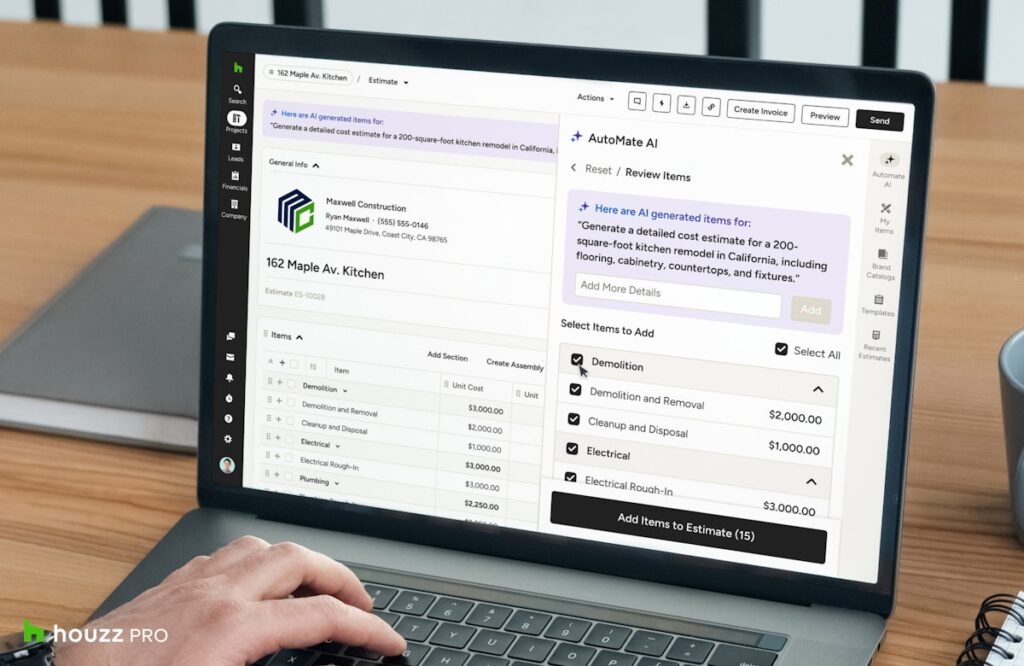On August 19, Houzz announced the expansion of its Houzz Pro software, unveiling a new suite of AI-powered tools known as AutoMate AI. Designed specifically for construction and design professionals, these features seek to streamline time-intensive administrative tasks by automating important processes such as financial document creation, task management, and expense tracking. This advancement comes in response to the increasing need for efficiency in project management, with a 2025 Houzz report indicating that administrative duties are the primary drivers of AI adoption in the construction and design sectors.
For small and medium-sized business (SMB) leaders, these updates offer an immediate opportunity to enhance productivity and effectively manage workflows, both in the office and remotely. The automation capabilities of AutoMate AI focus on reducing data entry and task management burdens, allowing contractors to concentrate on core project activities and client relationships. With continuous advancements in technology, implementing automation is about identifying the right tools and processes to enhance operational efficiency.
One prominent feature of the AutoMate AI expansion is its AI Document capability, which enables users to generate estimates, proposals, and invoices through text or voice input. This is far more efficient than traditional methods, where detailed input is necessary, and the risk of errors in data entry is ever-present. To implement similar automation in your SMB, consider using platforms like Make or Zapier. These allow users to set workflows that connect various applications. For instance, you could create a workflow that takes project details from an email and inputs them directly into your accounting software, creating an invoice automatically. Start by defining the necessary inputs and designing the workflow on the chosen platform, ensuring it covers all essential details for accurate estimates.
Another crucial aspect of workflow automation offered by AutoMate AI is the AI Tasks feature. This capability uses project logs and notes to generate a list of relevant tasks for follow-up or delegation. To replicate this feature, small business leaders can utilize project management tools like Asana or Trello in tandem with automation platforms. For example, set up an automated process that takes notes from daily project meetings, parses them for actionable insights, and automatically creates tasks in your project management system. This not only reduces the backlog of tasks but ensures that critical items are never overlooked.
Expense tracking can be a significant burden for SMBs, especially when dealing with multiple projects. The AI Expenses functionality allows contractors to log expenses through a simple photo of a receipt, which is then automatically categorized and linked to the relevant project. To achieve a similar effect, deploy expense management tools like Expensify or receipt management features within accounting software. With automation platforms, you can create a workflow that captures photos of receipts submitted via email or application, extracts relevant information, and updates your financial records. This reduces the time spent managing finances while also minimizing the risk of lost receipts or erroneous entries.
As you consider these implementations, it is vital to weigh the opportunities and risks associated with automation. While automation can significantly improve efficiency and accuracy, the initial setup can require time and resources. Training staff on new systems is also essential to ensure a smooth transition. However, the potential return on investment (ROI) is compelling. An investment in automation tools can lead to reduced administrative costs, enhanced project management capabilities, and ultimately, improved client satisfaction through timely and accurate deliverables.
The integration of automation in daily operations not only alleviates the administrative burden but also enhances decision-making capabilities. With accurate data at your fingertips, you can assess project performance in real time, allowing you to make informed strategic decisions that align with your business goals.
In conclusion, the introduction of Houzz’s AutoMate AI features illustrates a broader trend toward automation in the construction and design sectors. For SMB leaders, adopting similar automation strategies offers an actionable pathway to streamline workflows and improve efficiency. By leveraging AI tools and platforms like Make or Zapier, your business can enhance productivity, minimize errors, and focus more wholeheartedly on fulfilling client needs.
FlowMind AI Insight: Automation tools like AutoMate AI represent a pivotal opportunity for SMB leaders to streamline operations and reduce costs. Embracing these technologies not only facilitates immediate gains in productivity but also positions your business advantageously for future growth in an increasingly digital marketplace.
Original article: Read here
2025-09-05 15:04:00

